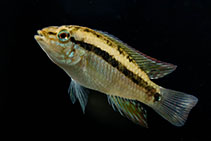
|
Apistogramma kullanderi Varella & Sabaj Pérez, 2014 |

|
|
photo by
Aas Midtun, H. |
| Family: | Cichlidae (Cichlids), subfamily: Geophaginae | |||
| Max. size: | 7.97 cm SL (male/unsexed); 5.87 cm SL (female) | |||
| Environment: | benthopelagic; freshwater | |||
| Distribution: | South America: upper rio Curuá (Iriri-Xingu drainage) and two of its larger tributaries on Serra do Cachimbo in Brazil. | |||
| Diagnosis: | Dorsal spines (total): 13-16; Dorsal soft rays (total): 6-8; Anal spines: 3-3; Anal soft rays: 7-8; Vertebrae: 23-24. Apistogramma kullanderi is distinguished from congeners by the different color pattern between mature females and males. Mature females differ from all congeners by the unique combination of intense dark pigmentation continuous along basal portion of dorsal fin and on ventral surfaces from gular region to anal-fin base. Among nominal species of Apistogramma, that pattern is most closely approximated by mature females of A. baenschi, distinguished from A. kullanderi by having dark pigmentation in dorsal fin discontinuous, alternating with pale regions. Mature males of A. kullanderi possess a coarse, irregular pattern of dark spots and vermiculations on cheek and opercular series, and sides with 10-12 dark stripes, each stripe occupying junction between adjacent scale rows and separated by paler region central to each scale. Among nominal species of Apistogramma, a similar pattern is found in mature males of A. rubrolineata and A. tucurui. Mature males of A. kullanderi are distinguished from these species by having enlarged jaws with large, fleshy lips (vs. jaws and lips not enlarged), five (vs. four) dentary pores, and head profile acutely angular with distinct concavity in interorbital region (vs. profile more broadly rounded, lacking concavity in interorbital region). Apistogramma kullanderi is also separated from all congeners by having a maximum size of 7.97 cm SL for a wild-caught adult male (vs. 6.53 cm SL among wild-caught congeners). Other characters useful for the identification of A. kullanderi are the following: body depth 34.2-41.3 % SL; caudal fin broad and evenly rounded; 1-4 rakers first gill arch; most scales in lateral line with distinct tube (vs. simple perforation); and immature individuals with dark midlateral band, lacking midlateral blotch (98797). | |||
| Biology: | Collected from shallow, sluggish backwaters shaded by bank vegetation (Ref. 98797). | |||
| IUCN Red List Status: | Not Evaluated (N.E.) Ref. (130435) | |||
| Threat to humans: | harmless | |||